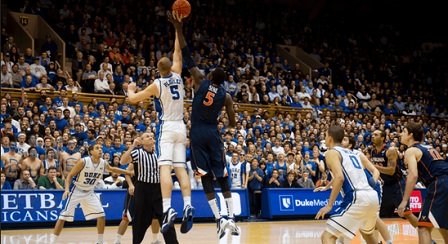The number of 5-star high school basketball recruits, which typically ranges from around 20 to 30 players nationally each year, reflects the elite talent pool of young athletes across the United States. These players are widely regarded as the cream of the crop in their respective recruiting classes, possessing exceptional skills, athleticism, and potential that attract attention from college basketball programs and media outlets alike
The process of evaluating and ranking high school basketball recruits involves thorough assessment by various recruiting services such as ESPN, 247Sports, and Rivals. These services employ a combination of scouting, expert analysis, statistical data, and feedback from coaches to assign star ratings to prospects. While there can be slight discrepancies in rankings among different services, 5-star recruits are universally recognized as top-tier talents who have demonstrated outstanding performance on the court.
Navigating the Labyrinth of High School Basketball Ranking Systems
high school basketball ranking systems can feel like venturing into a complex maze filled with twists and turns. At the heart of this labyrinth lie various recruiting services, each offering its own set of rankings, evaluations, and star ratings for prospects. Understanding and interpreting these rankings requires careful navigation through a landscape fraught with subjectivity, biases, and evolving player evaluations.
One of the key challenges in navigating this labyrinth is deciphering the methodology behind each ranking system. Recruiting services employ a combination of factors to evaluate prospects, including on-court performance, statistical data, physical attributes, skill level, potential, and intangibles such as work ethic and character. However, the weight given to each factor can vary between services, leading to discrepancies in rankings and star ratings.
Moreover, the subjectivity inherent in player evaluations can further complicate matters. Scouts and analysts may have differing opinions on a player’s abilities, potential, and future trajectory, leading to divergent rankings between different services. Additionally, biases, whether conscious or unconscious, can influence evaluations, particularly when it comes to factors like race, region, or affiliations with certain AAU programs or high schools.
Another challenge lies in the volatility and fluidity of player rankings. High school basketball is a dynamic and ever-changing landscape, with players constantly developing, evolving, and emerging onto the scene. A player who may be relatively unknown one season could suddenly skyrocket up the rankings due to improvements in their game, breakout performances, or increased exposure on the national stage.
The influence of external factors, such as recruiting hype, media coverage, and social media buzz, can further muddy the waters of player evaluation. Players who generate significant buzz on social media platforms or receive attention from prominent college programs may see their stock rise in the rankings, regardless of their actual on-court performance or skill level.
Despite these challenges, navigating the labyrinth of high school basketball ranking systems is not an insurmountable task. Coaches, players, and fans can employ several strategies to navigate this complex landscape effectively:
Diversify Information Sources: Instead of relying solely on one recruiting service, consider consulting multiple sources of information, including scouting reports, game footage, personal observations, and independent evaluations from trusted experts.
Understand Methodologies: Take the time to understand the methodologies and criteria used by each recruiting service when evaluating prospects. This can provide valuable insights into the strengths and limitations of each ranking system.
Look Beyond Rankings: While rankings and star ratings are useful tools for evaluating prospects, they should not be viewed as definitive indicators of future success. Consider factors such as fit within a team’s system, work ethic, character, and potential for development.
Focus on Long-Term Development: Instead of fixating solely on current rankings, focus on the long-term development and trajectory of players. Some prospects may be late bloomers who continue to improve and excel at the collegiate or professional level.
Trust Your Instincts: Ultimately, trust your instincts and judgments when evaluating players. While recruiting services can provide valuable insights, nothing beats firsthand observation and evaluation.
Beyond the High School Basketball Number Game: A Holistic View
The 5-Star High School Basketball Number Game: A Holistic View” delves into the intricacies of player evaluation beyond star ratings, offering a comprehensive perspective on the diverse talent pool within high school basketball.
While 5-star recruits command attention, they represent just a fraction of the broader landscape. This holistic view acknowledges the multitude of factors that contribute to a player’s success, transcending numerical rankings. Attributes like work ethic, character, and basketball IQ are equally vital in shaping a player’s trajectory.
The narrative explores the stories of overlooked talents who defy expectations and excel on their own terms. It highlights the importance of recognizing potential beyond star ratings and embracing the unique journeys of every player. Ultimately, success in high school basketball hinges on a blend of talent, determination, and opportunity, making it a game where every player’s story matters.
Conclusion
In conclusion, the number of 5-star high school basketball recruits fluctuates annually, typically ranging from around 20 to 30 players nationally. While these recruits represent the cream of the crop in terms of talent and potential, it’s essential to recognize that they are just one facet of the broader high school basketball landscape. Success in basketball is not solely determined by star ratings; factors such as work ethic, character, and opportunity also play crucial roles. Moreover, there are numerous players outside the 5-star designation who go on to have impactful collegiate and professional careers. Ultimately, the 5-star recruits are celebrated, but they are part of a larger tapestry that includes players of all backgrounds and abilities, each contributing to the rich and diverse fabric of the sport.





